![]()
![]()
![]()
Use LEFT and RIGHT arrow keys to navigate between flashcards;
Use UP and DOWN arrow keys to flip the card;
H to show hint;
A reads text to speech;
100 Cards in this Set
- Front
- Back
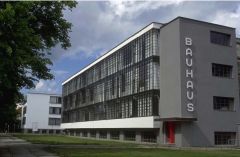
|
Bauhaus Workshop Wing Walter Gropius 1926 Dessau, Germany Front of classroom block composed of horizontal windows to ensure adequate lighting. Conception of space dominated by the interplay between inside and outside through the glass wall. |
|

|
Tea Infuser (produced in Bauhaus metal shop) Marianne Brandt 1924 Weimar, Germany Intended to distill a concentrated extract which can produce tea of any desired strength when combined with hot water in the cup. Circular lid is placed off center to avoid drips. Reinvented the elements as abstract geometric forms, creating a sculptural statement. |
|
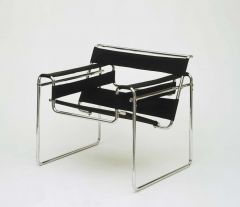
|
Wassily Chair Marcel Breuer 1925 Germany Inspired by the frame of a bicycle and influenced by the constructivist theories of the De Stjil movement. Fabricated using the techniques of local plumbers. |
|
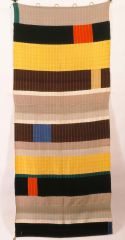
|
Wall Hanging Anni Albers 1925 Germany Designs are based on color relationships reflecting the principles of ALbers's studies at the Bauhaus. Relied heavily on hands-on experimentation with materials and on industrial aspects of textile production. |
|
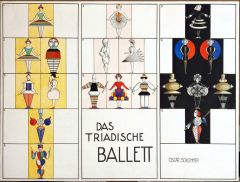
|
Costume Designs for Das Triadische Ballett Oskar Schlemmer 1926 Germany Focused on the problem of the figure in space. Became intrigue with possivilities of figures and their relationship to the space around them. |
|
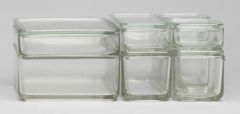
|
Kubus Storage Containers Wilhelm Wagenfeld 1938 Germany Geometric forms represented the kinda of mass-produced objects that the Bauhaus aspired to produce. Stackable, modular, space-saving and hygienic. Encouraged the thrifty use of leftovers. |
|
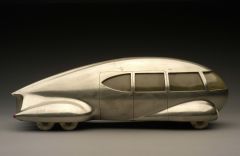
|
Model of Motor Car Number 9 Norman Bel Geddes 1932 USA Embraced the idea of streamlining - discovered that the teardrop/bullet shape was the most efficient and streamlined Offered excellent visibility through the use of curved glass for the windshield and windows. |
|
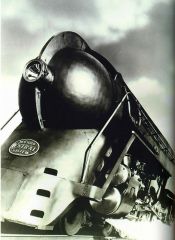
|
20th Century Limited Henry Dreyfuss 1932 USA Was advertised as the "Most Famous Train in the World", was redesigned. New York central to Chicago, Illinois |
|
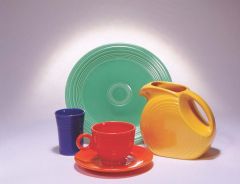
|
Fiesta Dinnerware Frederick Rhead 1936 USA The tableware was produced in multiple colors. Creates and informal mix and match of objects. |
|

|
Service Station for Texaco Walter Dorwin Teague 1936 USA Designed to have rounded corners and smooth surfaces to create a streamlined style. |
|
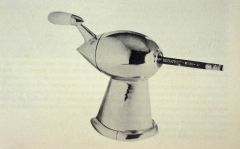
|
Teardrop Pencil Sharpener Raymond Loewy 1934 USA Inspired by the teardrop shape of airplanes and its sense of streamlining. |
|
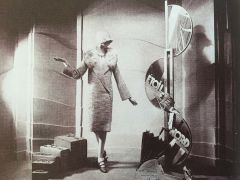
|
Franklin Simon Store window display in NY Norman Bel Geddes 1927 USA |
|
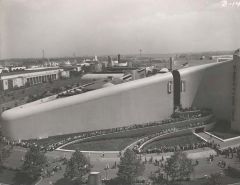
|
Futurama or "Highways of Horizons" Exhibit at General Motors New York World's Fair "The World of Tomorrow" Norman Bel Geddes 1939-40 USA Presented as a possible model of the world 20 years into the future. Provided a direct connection between the streamlined style and the concept of steady-flow. |
|

|
Installation view of the Exhibition "Organic Design in Home Furnishings" 1941 New York, USA Introduced the furniture designs of Charles Eames and Eero Saarinen to the world. |
|
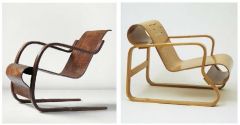
|
Paimio Chairs Alvar Aalto 1931-32 Finland Freeform organic shapes Harmonious relationship between structure and form |
|
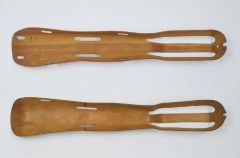
|
Leg Splint Charles and Ray Eames 1942 USA First of the plywood pieces to be mass produced Metal ones were heavier and less hygienic, wood ones can float Based on average persons average leg size |
|
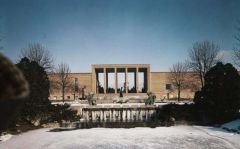
|
Cranbrook School Eliel Saarinen 1928-41 Bloomfield Hills, Michigan, USA Conception and design of the Cranbrook school was greatly influenced by the Arts and Crafts Movement |
|
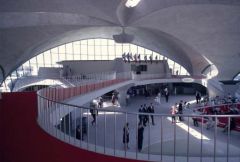
|
Interior of TWA Flight Center at JFK Airport Eero Saarinen 1958-1962 New York, USA Original design featured a prominent wing-shaped thin shell roof over the headhouse |
|
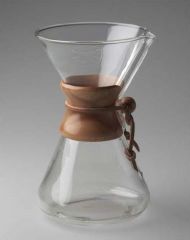
|
Chemex Coffee Maker Peter Schlumbohm 1941-42 USA Modified the lab funnel by adding an air channel and a pour spout, Handle made out of wood |
|
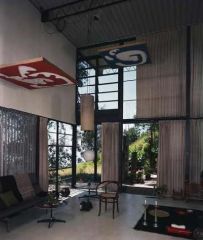
|
Interior of Case Study House No. 8 Charles and Ray Eames 1949 California, USA Also known as the "Eames House". It's idea is to hypothesize a modern household that has elaborate functional requirements. Designed to express man's life in the modern world. |
|

|
Lounge Chair and Ottoman Charles and Ray Eames 1956 USA Investigated into molding plywood. Sought to design a modern version of the English club chair. |
|
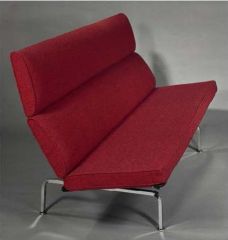
|
Sofa Compact Charles and Ray Eames 1954 USA Would be shipped in a small box. Perfectly scaled for spaces too small for a traditional sofa |
|
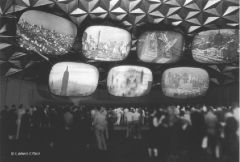
|
Glimpses of the USA at the American Exhibition in Moscow Charles and Ray Eames 1959 USA (Created), Moscow (Shown) Images demonstrated that highways and automobiles were part of the fabric of American life. However, the images also depicted loving images of families. |
|
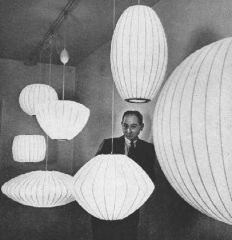
|
Bubble Lamps George Nelson and William Renwick 1952 USA Made of taut plastic that coats a steel wire frame. Nelson believed that furniture should be a simple, direct expression of construction with existing techniques. |
|
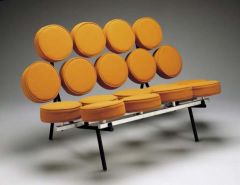
|
Marshmallow Sofa George Nelson and Irving Harper 1954-55 USA Approached by an inventor who had created injection plastic discs that could be produced inexpensively and would be durable. The cushions turned out to be impractical but the design was so intriguing that Herman MIller decided to manufacture it. |
|
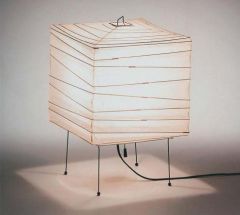
|
Akari Light Sculpture Isamu Noguchi 1951 USA Paper lanterns are harmonious blend of Japanese handcraft and modernist form. Created from handmade washi paper and bamboo ribbing supported by a metal frame. |
|
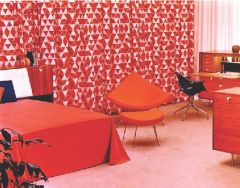
|
Coconut Chair (center) and Swag Leg Chair (right) George Nelson Associates 1955 and 1958 USA Created a design that lets the chair flex as the sitter moves. The slit between the seat and back helps prevent heat build-up. Look is light-scaled, sculpted and delicate but the base is strong. |
|
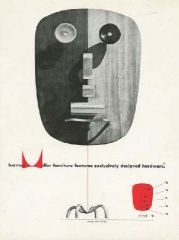
|
Magazine Advertisement and Harper's Logo for Herman Miller Irving Harper 1948 and 1947 USA Creates iconic "M" basing the logo around the letter. |
|
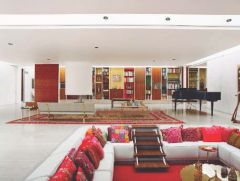
|
Miller House and Garden Alexander Girard, Eero Saarinen and Dan Kelly 1953 Columbus, Indiana, USA Commissioned by J. Irwin Miller. Expands upon an architectural tradition that epitomizes the international Modernist aesthetic. |
|
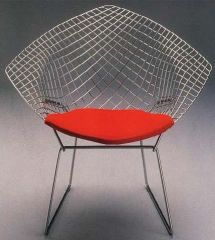
|
Diamond Chair Harry Bertoia 1952 USA Transformed industrial wire rods into a new furniture form. Given the freedom to work on whatever suited him at Knoll. |
|
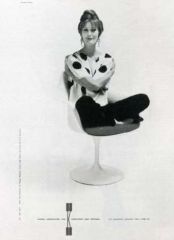
|
Advertisement for Knoll Tulip Chair Herbert Matter (ad) and Eero Saarinen (Chair) 1956 USA Wanted to eliminate the "slum of legs" that were found in chairs and tables with 4 legs. |
|
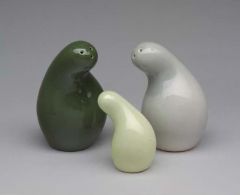
|
Town & Country Salt and Pepper Shakers Eva Zeisel 1945 USA One of the first to do earthenware in which the buyer could mix different colored pieces to create his or her own set. |
|
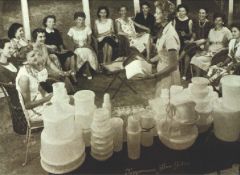
|
Tupperware Party Earl Tupper (Designer), Unknown Photographer 1947 USA Developed a method for purifying slag into a tough plastic. Created plastic containers that can be sealed with airtight, waterproof lids. Amassed a group of housewives to function as a multilevel sales organization. |
|
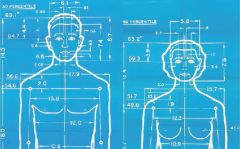
|
The Measure of Man ft. "Joe" and "Josephine" Anthropometric figures Henry Dreyfuss 1960 USA A collection of ergonomic reference charts providing designers with specifications for product designs |
|
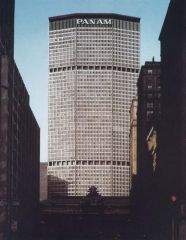
|
Pan Am Building Emery Roth & Sons, Pietro Belluschi and Walter Gropius 1960-63 USA Offered sweeping views of the city. Made up of octagonal stories. Posed huge problem to the pedestrian traffic and vehicles. |
|
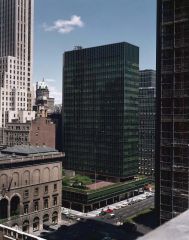
|
Lever House Skidmore, Owings & Merrill 1950-52 USA The second curtain wall skyscraper in NYC. Features an innovative courtyard and public space |
|
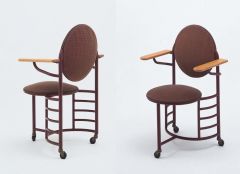
|
Office Chair for SC Johnson Wax Building Frank Lloyd Wright 1938 (manufactured) Wisconsin, USA Design rests on 3 legs rather than 4, cannot sit still unless you have good posture. |
|
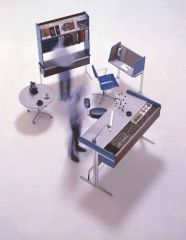
|
The Action Office I for Herman Miller Robert Propst and George Nelson 1964 USA Goal was to investigate how the world of work operated. Features workspaces of varying height to allow for freedom of movement. |
|
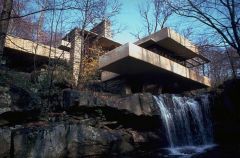
|
Falling Water (The Kaufmann House) Frank Lloyd Wright 1936 Pennsylvania, USA Built over a waterfall, it appears as thought it doesn't stand on solid ground. Places a strong emphasis on harmony between man and nature |
|
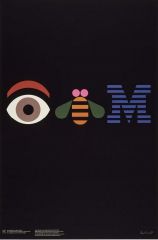
|
"Eye-Bee-M" Poster Paul Rand 1982 USA Designed in support of IBM's motto "THINK" |
|
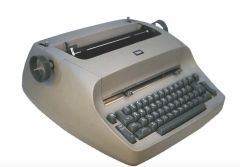
|
IBM Selectric Typewriter Eliot Noyes 1961 USA Instead of the "basket" of individual typebars, this used a "typeball" that rotated and pivoted to the correct positionReplayed the moving carriage with a paper roller that would stay in position while the typeball would move. |
|
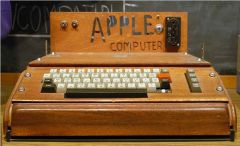
|
Apple I Computer Steve Wozniak and the Homebrew Computer Club 1975 USA Had a built in computer terminal circuitry which was distinctive. It was the first of the Apple Computers. |
|

|
Whole Earth Catalog Stewart Brand 1968 USA Public campaign to have NASA release the then-rumored satellite phot of the sphere of Earth as seen from space, the first image of the "whole earth" |
|
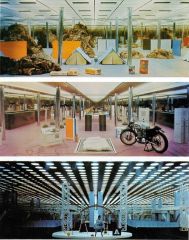
|
No-Stop-City Archizoom Associati 1969 Italy An unbuilt project with well documented drawings and photographs. Shows and infinitely extending grid interrupted only by natural features. Spaces are filled with rocks and branches, small pieces of nature brought inside the artificial world. |
|
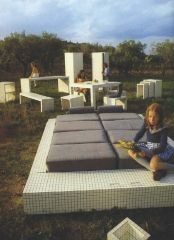
|
Quaderna for Zanotta Supertstudio 1969 Italy Commentary on political dissolution. Honeycomb core structure coated with white plastic laminate, silk-screen printed with black squares at 3cm spacing. |
|
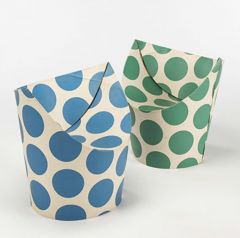
|
Spotty Chair for International Paper Peter Murdoch 1963 UK Influence of pop-art movement, not held together by anything, just folded. |
|

|
Panton Chair for Vitra Verner Panton 1960 Germany (manufactured) Captivated by the potential of plastic. Aim was to create a comfortable chair made of one piece that could be used anywhere. |
|
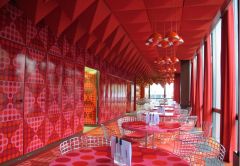
|
Der Spiegel Canteen for Der Spiegel Verner Panton 1969 Hamburg, Germany The canteen of the publishing house of the "Spiegel" magazine. Incorporates the Bertoia chair from Knoll |
|

|
Joe Armchair Paolo Lomazzi, Jonathan De Pas and Donato D'Urbino 1970 Italy Moulded polyurethane foam covered with cognac brown leather. Reminiscent of Pop-Art sculptures. Named after the baseball legend Joe Di Maggio. |
|
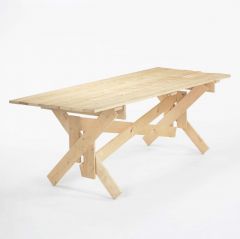
|
Autoprogettazione Enzo Mari 1974 Italy Offered 19 designs using readymade cuts of timber to build tables, chairs, bookshelves and beds. |
|

|
Italy: The New Domestic Landscape at MoMA Emilio Ambasz (Curator) 1972 USA Organized into two parts: Objects and Environments. Objects were selected and environments were commissioned because of their relevance to particular current attitudes toward the task of design. |
|
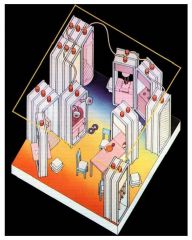
|
Micro Environment for Italy: The New Domestic Landscape at MoMA Ettore Sottsass Jr. 1972 USA |
|
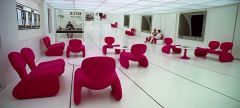
|
Djinn Chair (Airborne International) Olivier Mourgue 1965 France Stills from 2001: A Space Odyssey Stanley Kubrick (director), Frederick Ordway and Harry Lange 1968 USA Djinn refers to an Islamic spirit capable of changing shape. The low profile was an attempt to emulate the informal lifestyle of the time. |
|
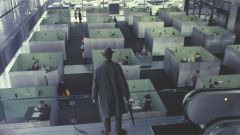
|
Still From Playtime Jacques Tati 1967 France Anticipated dominance of the cubicle arrangements by 20 years |
|
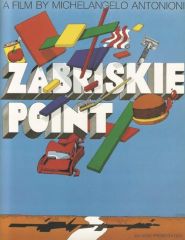
|
Poster for Michelangelo Antonioni's film Zabriskie Point Milton Glaser 1970 Italy (film), USA (graphic design) Interprets the explosion scene at the end of the movie and emphasizes the overarching theme of the movie by depicting icons of US culture exploding among debris. |
|

|
Model J39 Chair ("The Shaker Chair") Borge Mogensen 1947 Denmark Simple and beautiful. Beech wood frames and papercord seats |
|
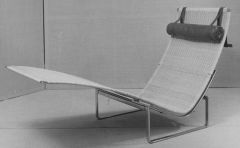
|
Hammock Chair 24 Poul Kjaerholm 1965-67 Denmark Headrest was covered in African goat skin Can adjust the chair to almost any angle simply by moving the seat on its base. Broke away from danish tradition of solid wood. |
|
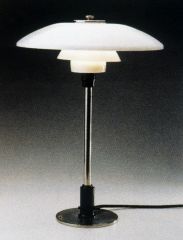
|
"PH" Table Lamp Poul Henningsen (designer), Produced by Louis Poulson 1927 Copenhagen Denmark Tried to design a lamp that solved the problem with glare. Looking to bring both art and industry together. |
|
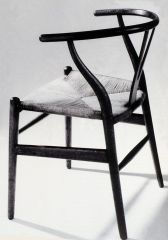
|
"Y-Chair" (CH-24) for Carl Hansen & Son
Hans Wegner 1949-50 Denmark Had back support, function and aesthetic. Created multiple variations. |
|
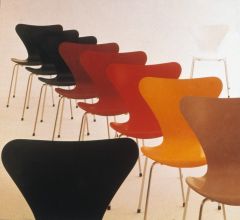
|
Variant of Model 3.100 ("Ant") Side Chair for Fritz Hansen Arne Jacobsen 1951 Denmark Using a new technique which could bend plywood in 3-dimensions. |
|
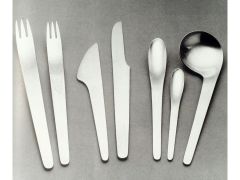
|
"AJ" Flatware in stainless Steel Arne Jacobsen, produced by A. Michelson 1957 Copenhagen, Denmark Compeltely devoid of ornament, highly sculptural: hard to fit whole thing in mouth. Easy to wash. Knife is sturdy but not sharp. Tines of the fork did not have the length of other forks. |
|
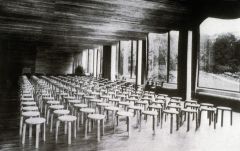
|
Lecture Hall, Viipuri Library Alvar Aalto 1935 Finland Undulating wooden ceiling in the lecture hall enables sound to reach the human ear more perfectly. |
|
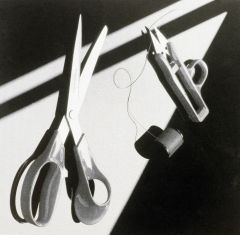
|
"O-Series" Scissors for Fiskars Olof Backstrom 1960 Finland Focused on producing metal items, wasn't until 60s that they experimented with stripped stainless steel and injection molded plastics. |
|

|
Bolle Vases, for Venini Tapio Wirkkala 1966 Finland Made of heavy solid glass. Gives an optical effect that glass is filled through the reflection of light. Still one of the leading producers of glass in the world. |
|

|
"Balans Variable" Seat Peter Opsvik 1980 Norway Design encourages support of body weight on knees which relieves pressure on your spine. This is the rocking version. |
|
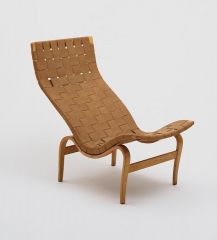
|
Eva Chair Bruno Mathsson 1934 Sweden Bent laminated beechwood and natural hemp webbing |
|
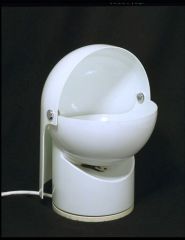
|
Pileo Lamp, Artemide Gae Aulenti 1972 Italy Adjustable pfizer, using a plastic top, the shade pivots like a helmet in order to direct the light. |
|

|
"Tizio" Lamp for Artemide Richard Sapper 1970 Italy Weighted in a way that could be rested in any position. Very innovated way to use electricity. Used color for functional things (e.g. buttons) |
|
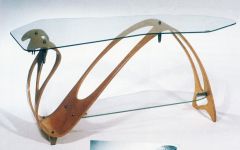
|
"Arabesco" Tea Table Carlo Mollino 1950 Italy Features bent plywood frame veneered with oak. The frame is fastened to the top by stainless steel discs fixed to the glass |
|

|
Vespa ("Wasp") 98 cc. Prototype Vespa 125 cc. Scooter with Self-Supporting Frame Corradino D'Ascanio 1945 and 1953 Italy |
|
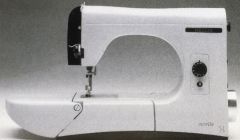
|
Necchi "Mirella" Sewing Machine Marcello Nizzoli 1956 Italy Distinct function of the Mirella was a hand-crank that allowed you to operate the machine without electricity. A truly portable design. |
|
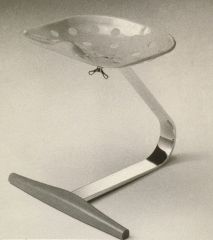
|
"Mezzadro" Stool Castiglioni Brothers 1957 Italy Each part clearly embodies its individual task within the overall functional interplay. An object is successful when all superfluous elements have been removed (stripped to the essentials) |
|
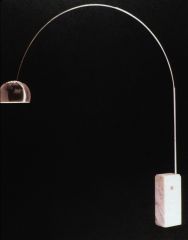
|
"Arco" Floor Lamp for Flos Castiglioni Bros. 1962 Italy Wanted to provide overhead lighting without requiring ceiling suspension, inspired by streetlights. Hole in the cement block was designed to perfectly fit a broom stick to allow people to easily carry it. |
|
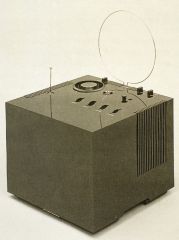
|
"Black 12" Television for Brionvega Marco Zanuso & Richard Sapper 1969 Italy |
|
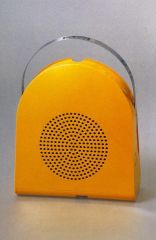
|
"GA 45 Pop" Record Player for Wohlleber & Co, Minerva Radio Mario& Dario Bellini 1968 Vienna, Italy Later produced as "Phono Boy" for Grundig |
|
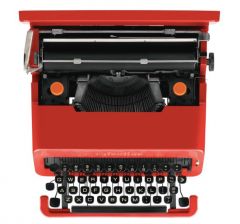
|
Valentine Typewriter for Olivetti Ettor Sottsass 1969 Italy Was technically mediocre, expensive and failed to sell to the mass audience. Design focused on its emotional connection to users. |
|

|
Destruction of Lassú Chair for Casabella Alessandro Mendini 1974 Italy Situates postmodernism as coming out of Italy. Staged as an art direction project: it is an object in performance. |
|
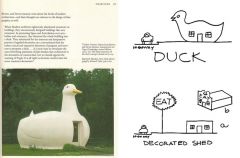
|
The "Duck" and the "Decorated Shed" from Learning From Las Vegas Robert Venturi and Denise Scott Brown 1972 USA When modernism abandoned ornament,the building itself became the ornament. Function is represented in the form. |
|

|
Vanna Venturi House Robert Venturi 1964 Philadelphia, USA Contradiction in the form of the building is very apparent, the form is asymmetrical. Approached the roof as thought it was a typical cartoon house. |
|
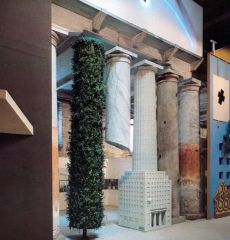
|
Façade from Strada Novissima Hans Hollein 1980 Venice Biennale Had 6 columns, the 2 on the sides were existing columns that were already on the sides of the building. |
|
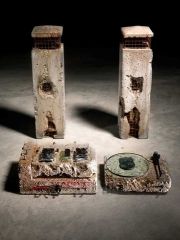
|
Concrete Stereo Ron Arad 1983 London Example of post-industrial aesthetics. Chose concrete as the medium for underlining its architectural character. |
|
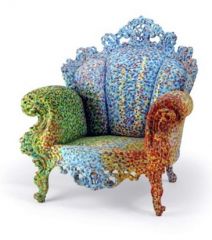
|
Proust Armchair Alessandro Mendini 1978 Italy Projected the painting onto the chair and painted each dot one by one. Reproduction of an enlarged section of a Pointillist painting by Signac. |
|

|
Carlton Bookshelf, Memphis Group Ettore Sottsass Jr 1981 Italy Traditional wall shelving is turned into a multipurpose, dynamic, encompassing object, that claims the right to stand unrestricted in its own space (like a sculpture). Can be dismantled. |
|
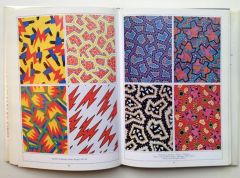
|
Textile Designs for Memphis Nathalie du Pasquier 1982 |
|
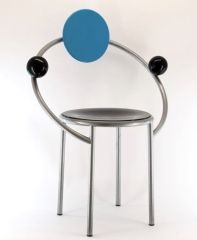
|
First Chair, Memphis Michele de Lucchi 1983 Italy Meant to be sit on with a bit of a slouch, with the ends of the elbows resting on the top of the balls. The flexible backrest can be moved to add comfort for the upper back. |
|

|
Sony Building Philip Johnson 1984 New York, USA First post-modern skyscraper. Divided into 3 main sections: entrance, tall shaft of identical floors, wide band of windows near the top. Graphic impact, lots of people started copying it in their designs. |
|
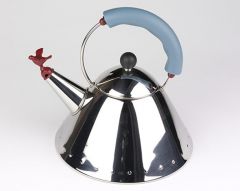
|
9093 Tea Kettle Michael Graves 1985 The bird "sings" when the water has boiled. |
|

|
How High the Moon Shiro Kuramata, Ishimaru Co. 1986 Japan Constructed entirely of steel mesh, with no interior frame support. Shape resembles conventional armchair but dematerialized with its almost transparent appearance. |
|
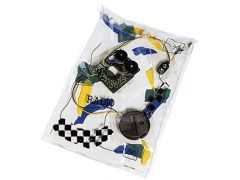
|
Radio in a Bag, Apex Daniel Weil 1981 Freed the inner workings of a common radio by housing them in clear plastic sleeves. Subverts the notion of the rectangular black box commonly associated with audio equipment at the time. |
|

|
Juicy Salif, Alessi Philippe Starck 1990 France Surprisingly effective in is functionality. Designed to squeeze citrus juice over top of dishes. |
|
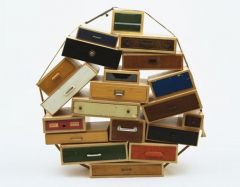
|
Chest of Drawers, Droog Tejo Remy 1991 The Netherlands Collected found drawers, gave them new enclosures and loosely bundled them into a chest. |
|
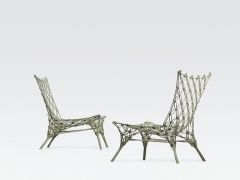
|
Knotted Chair, Droog/Cappellini Marcel Wanders 1996 The Netherlands Combines industrial techniques and handcrafting. Rope is knotted into the shape of a chair and then impregnated with epoxy resin. Hung in a frame to dry, the final form is in the hands of gravity. |
|
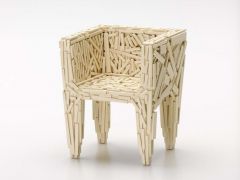
|
Favela Chair, Edra Fernando and Humberto Campana 1991 Brazil Natural materials combined with the apparent simplicity of construction. Made with simple strips of natural wood nailed one over the other by hand. Random arrangement makes it unique. |
|
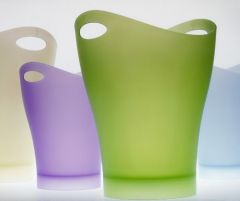
|
Garbo and Garbino, Umbra Karim Rashid 1996 USA The butterfly cut along the top makes the can seem elliptical. Rounded interior bottom makes it easier to clean. |
|
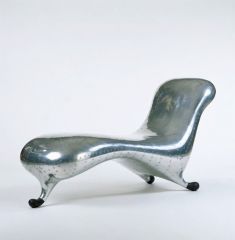
|
Lockheed Lounge Marc Newson 1986 Australia Drew inspiration for the shape from the recamier seating type. |
|
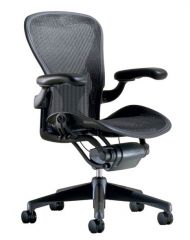
|
Aeron Chair, Herman Miller Donald Chadwick and BIll Stumpf 1992-94 USA Differentiation was a huge part of the Aeron design strategy. CHair is designed to be like the human form, biomorphic. (there are no straight lines) |
|
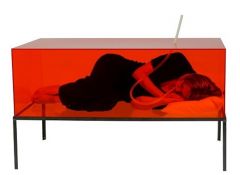
|
Faraday Chair, Hertzian Tales Anthony Dunne & Fiona Raby 1997 UK Conventional chairs often provide physical comfort, designers suggest this may provide psychological comfort by providing sanctuary. |
|
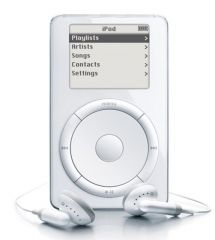
|
iPod, Apple Jonathan Ive and Apple Industrial Design Group 2001 USA Offered "1000 songs in your pocket". |
|
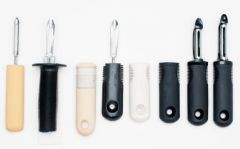
|
Good Grips Peeler prototypes based on user input, Oxo Smart Design 1989 USA Ergonomically designed, trans-generational tools that set a new standard for the industry |
|

|
Transparent Tools Jesse Howard 2012 The Netherlands Presents a future scenario where the user is actively involved with repairing and modifying their own products. Each product provided a single page manual with building instructions and links to download the 3D printed and CNC milled components. |

